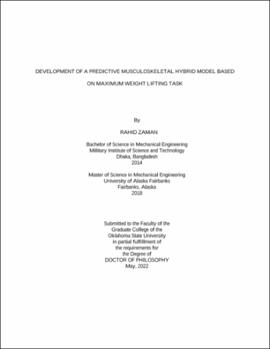| dc.contributor.advisor | Xiang, Yujiang Mike | |
| dc.contributor.author | Zaman, Rahid | |
| dc.date.accessioned | 2023-03-16T21:14:18Z | |
| dc.date.available | 2023-03-16T21:14:18Z | |
| dc.date.issued | 2022-05 | |
| dc.identifier.uri | https://hdl.handle.net/11244/337116 | |
| dc.description.abstract | Manual material handling (MMH), particularly lifting, is one of the main reasons for work-related joint and back injuries. Injuries associated with MMH play a significant role in the economy. Therefore, it is necessary to determine subject-specific maximum lifting weight and explain why these lifting-related injuries occur. However, it is challenging to determine the maximum lifting weight by experiments as it is a time-consuming process and risky for the participants. Computational biomechanical models can reveal the insight of human lifting motion and help us to find the reasons behind lifting-related injuries. Musculoskeletal models are complicated and computationally heavy, making them infeasible for real-time application. Skeletal models are computationally efficient but lack muscle physiology in their formulations. This makes it unable to assess musculoskeletal injuries. A novel hybrid model is introduced in this study to predict maximum lifting weight and lifting motion and to evaluate musculoskeletal injury for that lifting motion. The hybrid predictive model consists of a predictive skeletal module and an Opensim musculoskeletal module to balance the computational speed and physiological accuracy. The skeletal models predict joint torques, joint angle profiles, center of pressure (COP), and ground reaction forces (GRFs) for both symmetric and asymmetric liftings. The predicted joint angles, GRFs and COP are inputted into OpenSim musculoskeletal module to estimate muscle activations and joint reaction forces. The hybrid predictive models are used to analyze joint torques, muscle activations, and lumbar spine joint reaction forces for both symmetric and asymmetric lifting tasks to prevent musculoskeletal injuries. The developed hybrid model is also able to predict maximum lifting weight by using subject-specific dynamic joint strength and assess associated injury risks. The proposed hybrid model is both computationally efficient and generic, and it can be readily applied to other motions as well. The hybrid predictive musculoskeletal model has wide applications for workers’ injury prevention to reduce the risk of musculoskeletal disorders. | |
| dc.format | application/pdf | |
| dc.language | en_US | |
| dc.rights | Copyright is held by the author who has granted the Oklahoma State University Library the non-exclusive right to share this material in its institutional repository. Contact Digital Library Services at lib-dls@okstate.edu or 405-744-9161 for the permission policy on the use, reproduction or distribution of this material. | |
| dc.title | Development of a predictive musculoskeletal hybrid model based on maximum weight lifting task | |
| dc.contributor.committeeMember | Hausselle, Jerome | |
| dc.contributor.committeeMember | Wang, Shuodao | |
| dc.contributor.committeeMember | Fan, Guoliang | |
| osu.filename | Rana_okstate_0664D_17572.pdf | |
| osu.accesstype | Open Access | |
| dc.type.genre | Dissertation | |
| dc.type.material | Text | |
| dc.subject.keywords | hybrid model | |
| dc.subject.keywords | lifting | |
| dc.subject.keywords | motion prediction | |
| dc.subject.keywords | musculoskeletal model | |
| dc.subject.keywords | opensim | |
| dc.subject.keywords | skeletal model | |
| thesis.degree.discipline | Mechanical and Aerospace Engineering | |
| thesis.degree.grantor | Oklahoma State University | |
